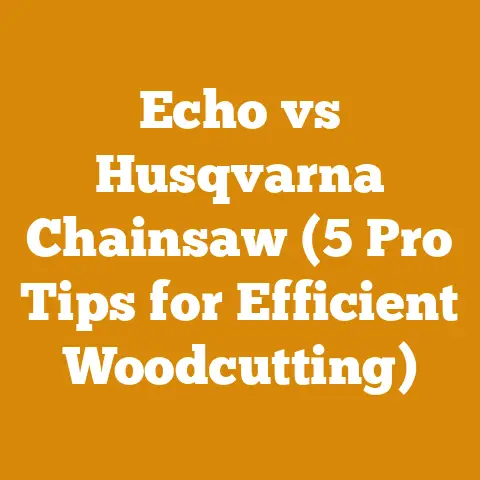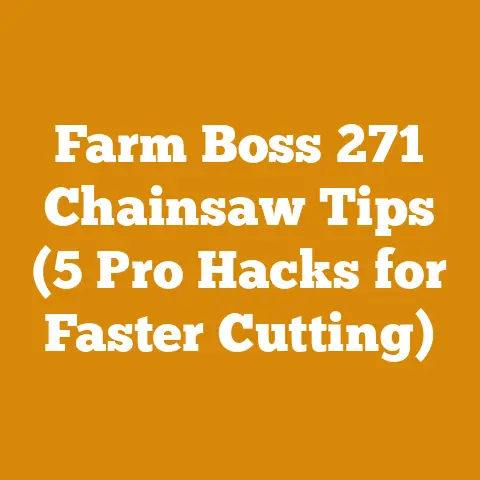How to Kill Bittersweet Vines (Pro Tips for Effective Removal)
“I was about ready to give up! Bittersweet was choking the life out of my apple trees. Nothing seemed to work. Then I stumbled on your guide, and finally, finally, I’m seeing results. Thanks for saving my orchard!” – John S., Upstate New York Orchard Owner
That’s the kind of message that makes all the sweat and sawdust worthwhile. Dealing with invasive species like Oriental bittersweet ( Celastrus orbiculatus) can feel like a never-ending battle. I know the frustration firsthand. I’ve spent years wrestling with these tenacious vines, not just on my own property, but also helping neighbors and local conservation groups. It’s a tough job, but someone’s gotta do it, and with the right knowledge and tools, you can win.
And let’s be honest, the firewood industry and even small-scale logging operations often find themselves battling bittersweet. It can quickly overrun a woodlot, hindering tree regeneration and making timber harvesting a nightmare. So, whether you’re protecting your prized trees, managing a woodlot, or just reclaiming your backyard, this guide is designed to provide you with the pro tips you need for effective bittersweet removal.
Before we dive in, let’s set the stage. Globally, invasive species are a massive problem, costing billions in control efforts and ecological damage. In the US alone, the estimated economic impact is over $120 billion annually. Oriental bittersweet, in particular, is a major culprit in the eastern United States, aggressively outcompeting native vegetation and impacting biodiversity. Its rapid growth and prolific seed production make it a formidable foe.
Now, let’s get our hands dirty!
How to Kill Bittersweet Vines: Pro Tips for Effective Removal
This isn’t just about hacking away at vines with a machete (though sometimes, that’s a satisfying first step!). We’re going to cover a multi-pronged approach, focusing on methods that are effective, environmentally responsible, and tailored to different situations.
Understanding Your Enemy: Oriental Bittersweet 101
Before you go to war, you need to know your enemy. Oriental bittersweet is a deciduous, woody vine that can grow up to 60 feet long. It’s easily identified by its alternate, oval-shaped leaves and, most notably, its bright red berries that mature in the fall. These berries are a major reason why it spreads so quickly – birds love them and distribute the seeds far and wide.
Key characteristics to remember:
- Vigorous Growth: Bittersweet can grow several feet in a single season.
- Girdling: It wraps tightly around trees, restricting their growth and potentially killing them.
- Extensive Root System: The roots are deep and resilient, making complete removal difficult.
- Seed Production: A single female plant can produce thousands of seeds annually.
- Vegetative Reproduction: It can also spread through root suckers, creating new plants from existing roots.
Assessing the Infestation: Know What You’re Up Against
Before you start swinging tools, take a good look at the situation. How widespread is the infestation? Are the vines climbing trees, covering fences, or sprawling across the ground? This assessment will help you choose the most appropriate removal methods.
Consider these factors:
- Size of the Infested Area: Is it a small patch or a large area?
- Age of the Vines: Are they young seedlings or mature, woody vines?
- Presence of Desirable Plants: Are there native plants you want to protect?
- Accessibility: Can you easily reach the vines, or are they in a difficult location?
- Your Resources: How much time, energy, and money are you willing to invest?
Method 1: Manual Removal – The Hands-On Approach
This is often the best option for small infestations or when you want to avoid using herbicides. It’s labor-intensive, but it’s also the most environmentally friendly.
Tools You’ll Need:
- Gloves: Essential for protecting your hands from thorns and irritants.
- Pruning Shears or Loppers: For cutting smaller vines.
- Hand Saw or Axe: For cutting larger vines and stems.
- Shovel or Mattock: For digging out roots.
- Tarp or Wheelbarrow: For collecting and disposing of the vines.
Step-by-Step Guide:
- Cut the Vines at the Base: Use pruning shears, loppers, a hand saw, or an axe to cut the vines as close to the ground as possible. For larger vines, I recommend a sharp axe. A dull axe is dangerous, and you’ll tire out quickly. Remember the mantra: “Sharp axe, safe axe.”
- Remove Vines from Trees (Carefully!): Gently pull the vines down from trees. Be careful not to damage the bark of the trees. If the vines are tightly entwined, you may need to cut them into smaller sections to remove them safely. This is where patience comes in. Don’t force anything.
- Dig Out the Roots: Use a shovel or mattock to dig around the base of the cut stems and remove as much of the root system as possible. This is the most challenging part, as the roots can be extensive and deep.
- Dispose of the Vines Properly: Bittersweet vines can re-root if left on the ground, so it’s important to dispose of them properly. You can burn them (where permitted), compost them (if they haven’t produced seeds), or bag them up and send them to a landfill.
- Monitor and Repeat: Bittersweet is persistent, so you’ll need to monitor the area regularly and remove any new growth that emerges from remaining root fragments. This may require multiple treatments over several years.
Pro Tips for Manual Removal:
- Timing is Key: The best time to manually remove bittersweet is in the late fall or early winter, after the leaves have fallen but before the ground freezes. This makes it easier to see the vines and dig out the roots.
- Target the Root Crown: The root crown (the area where the stem meets the roots) is the most important part to remove. If you can remove the root crown, you’ll prevent the plant from resprouting.
- Be Thorough: Even small pieces of root can resprout, so be as thorough as possible when digging out the roots.
- Mulch the Area: After removing the vines and roots, mulch the area with wood chips or other organic material to suppress new growth.
- Persistence Pays Off: Manual removal requires persistence. Don’t get discouraged if you see new growth. Keep at it, and eventually, you’ll win the battle.
A Personal Anecdote:
I remember one particularly stubborn bittersweet infestation that I tackled in a local park. The vines had completely engulfed a stand of young oak trees. I spent weeks meticulously cutting and pulling vines, digging out roots, and hauling away debris. It was back-breaking work, but the satisfaction of seeing those oak trees finally free to grow was immense. It’s a reminder that manual removal, while challenging, can be incredibly rewarding.
Method 2: Herbicide Application – The Chemical Approach
When manual removal isn’t feasible, herbicide application may be necessary. This is particularly true for large infestations or when the vines are growing in difficult-to-reach areas.
Important Considerations:
- Choose the Right Herbicide: Select an herbicide that is specifically labeled for use on woody vines and that is effective against bittersweet. Glyphosate (e.g., Roundup) and triclopyr (e.g., Garlon) are two common options.
- Follow Label Instructions: Always read and follow the label instructions carefully. This is crucial for your safety and for the effectiveness of the herbicide.
- Consider Environmental Impacts: Herbicides can have negative impacts on the environment, so use them judiciously and avoid spraying non-target plants.
- Wear Protective Gear: Wear gloves, eye protection, and long sleeves when applying herbicides.
Application Methods:
There are two main methods for applying herbicides to bittersweet vines:
- Cut-Stump Treatment: This method involves cutting the vines at the base and applying herbicide directly to the freshly cut stump. This is a targeted approach that minimizes the risk of harming non-target plants.
- Foliar Spray: This method involves spraying the leaves of the vines with herbicide. This is a more efficient approach for large infestations, but it also carries a higher risk of harming non-target plants.
Step-by-Step Guide (Cut-Stump Treatment):
- Cut the Vines: Use pruning shears, loppers, a hand saw, or an axe to cut the vines as close to the ground as possible.
- Apply Herbicide: Within minutes of cutting the vines, apply herbicide to the freshly cut stump. Use a paintbrush, spray bottle, or a specialized herbicide applicator to apply the herbicide directly to the outer layer (cambium) of the stump.
- Monitor and Repeat: Check the treated stumps regularly for new growth. If you see any sprouts, reapply herbicide.
Step-by-Step Guide (Foliar Spray):
- Prepare the Herbicide Solution: Mix the herbicide with water according to the label instructions.
- Apply the Herbicide: Use a backpack sprayer or a handheld sprayer to apply the herbicide to the leaves of the vines. Be sure to thoroughly wet the leaves, but avoid overspraying.
- Avoid Spraying Non-Target Plants: Use a shield or a directed spray nozzle to prevent the herbicide from drifting onto desirable plants.
- Monitor and Repeat: Check the treated vines regularly for signs of herbicide damage. It may take several weeks for the vines to die completely. You may need to repeat the application to control new growth.
Pro Tips for Herbicide Application:
- Timing is Key: The best time to apply herbicides is in the late summer or early fall, when the plants are actively transporting nutrients to their roots. This will help the herbicide move throughout the plant and kill it more effectively.
- Use a Surfactant: Adding a surfactant (a type of soap) to the herbicide solution can help it stick to the leaves and penetrate the plant’s waxy cuticle.
- Avoid Spraying on Windy Days: Wind can cause the herbicide to drift onto non-target plants.
- Consider Weather Conditions: Avoid spraying herbicides before or during rain, as the rain can wash the herbicide off the leaves.
- Protect Water Sources: Be careful not to contaminate water sources when applying herbicides.
Data-Backed Insights:
Studies have shown that cut-stump treatment with glyphosate or triclopyr is highly effective in controlling bittersweet. In one study, cut-stump treatment with glyphosate resulted in 95% control of bittersweet after one year. Foliar spray can also be effective, but it may require multiple applications to achieve similar results.
A Word of Caution:
Herbicide use is a serious decision, and it’s important to weigh the risks and benefits carefully. If you’re not comfortable using herbicides yourself, consider hiring a professional to do the job.
Key Principles of IPM:
- Prevention: Take steps to prevent bittersweet from becoming established in the first place.
- Monitoring: Regularly monitor your property for signs of bittersweet infestation.
- Identification: Accurately identify the pest you’re dealing with.
- Thresholds: Determine the level of infestation that you can tolerate.
- Control Methods: Choose the most effective and environmentally responsible control methods.
- Evaluation: Evaluate the effectiveness of your control methods and adjust your strategy as needed.
IPM Strategies for Bittersweet Control:
- Plant Native Species: Native plants are better adapted to the local environment and can compete more effectively with invasive species like bittersweet.
- Maintain Healthy Trees: Healthy trees are more resistant to bittersweet infestation.
- Remove Seedlings Early: Regularly inspect your property for bittersweet seedlings and remove them before they become established.
- Use Manual Removal in Sensitive Areas: In areas where you want to avoid using herbicides, use manual removal to control bittersweet.
- Use Herbicides Judiciously: Use herbicides only when necessary and apply them carefully to minimize environmental impacts.
A Case Study in IPM:
A local conservation group that I work with implemented an IPM strategy to control bittersweet in a large nature preserve. They started by mapping the extent of the infestation and identifying areas where native plants were particularly vulnerable. They then used a combination of manual removal and herbicide application to control the bittersweet. In sensitive areas, they focused on manual removal, while in heavily infested areas, they used cut-stump treatment with glyphosate. They also planted native trees and shrubs to help suppress bittersweet growth. Over several years, they were able to significantly reduce the bittersweet infestation and restore the health of the native ecosystem.
Preventing Future Infestations: The Long Game
Once you’ve successfully removed bittersweet, it’s important to take steps to prevent it from coming back. This requires a long-term commitment and a proactive approach.
Key Preventative Measures:
- Regular Monitoring: Regularly inspect your property for signs of bittersweet seedlings or resprouts.
- Prompt Removal: Remove any new growth as soon as you see it.
- Maintain Healthy Vegetation: Healthy vegetation can compete more effectively with bittersweet.
- Avoid Disturbing the Soil: Soil disturbance can create opportunities for bittersweet to germinate.
- Educate Others: Educate your neighbors and community about the dangers of bittersweet and how to control it.
Firewood and Bittersweet:
If you’re involved in firewood preparation, be extra vigilant. Bittersweet can easily spread through firewood if the vines are present on the wood. Always inspect your firewood for bittersweet vines and remove them before storing or transporting the wood.
Unique Insights on Wood Species and Bittersweet:
Interestingly, some wood species seem to be more susceptible to bittersweet infestation than others. For example, I’ve noticed that bittersweet tends to thrive on trees with rough bark, like oaks and maples, as the rough bark provides a better grip for the vines. Smooth-barked trees, like beeches and birches, seem to be less susceptible. While this is anecdotal, it’s something to keep in mind when managing your woodlot.
Costs and Budgeting: The Bottom Line
Bittersweet removal can be expensive, especially if you’re dealing with a large infestation. It’s important to factor in the costs of tools, herbicides, labor, and disposal when budgeting for your project.
Cost Breakdown:
- Tools: Pruning shears, loppers, hand saws, axes, shovels, mattocks, sprayers (cost can range from \$50 to \$500+ depending on quality and type).
- Herbicides: Glyphosate, triclopyr (cost can range from \$20 to \$100+ per gallon).
- Labor: If you’re hiring someone to do the work, labor costs can range from \$50 to \$100+ per hour.
- Disposal: Disposal fees for yard waste can vary depending on your location.
Budgeting Tips:
- Prioritize: Focus on controlling bittersweet in areas where it’s causing the most damage.
- DIY: Do as much of the work yourself as possible to save on labor costs.
- Shop Around: Compare prices on tools and herbicides at different retailers.
- Apply for Grants: Some organizations offer grants for invasive species control projects.
Troubleshooting and Common Pitfalls: Learning from Mistakes
Even with the best planning, things can go wrong. Here are some common pitfalls to avoid:
- Not Identifying the Plant Correctly: Make sure you’re actually dealing with Oriental bittersweet and not a similar-looking native vine.
- Not Following Label Instructions: Always read and follow the label instructions when using herbicides.
- Damaging Non-Target Plants: Be careful not to harm desirable plants when removing or spraying bittersweet.
- Not Removing Enough of the Root System: Bittersweet can resprout from even small pieces of root.
- Not Monitoring Regularly: Bittersweet is persistent, so you need to monitor the area regularly for new growth.
- Giving Up Too Soon: Bittersweet control can take time and effort. Don’t get discouraged if you don’t see results immediately.
A Troubleshooting Story:
I once made the mistake of applying herbicide on a windy day. The herbicide drifted onto a patch of my prized blueberry bushes, and I ended up killing several of them. It was a costly lesson, but it taught me the importance of paying attention to weather conditions when applying herbicides.
Next Steps and Additional Resources: Continuing the Fight
Congratulations! You’ve taken the first steps towards controlling bittersweet on your property. But the fight isn’t over yet. Here are some next steps you can take:
- Continue Monitoring: Regularly inspect your property for new growth.
- Refine Your Strategy: Adjust your control methods as needed based on your results.
- Seek Expert Advice: If you’re struggling to control bittersweet, consult with a professional arborist or invasive species specialist.
- Join a Local Conservation Group: Get involved in local conservation efforts to help control invasive species in your community.
Additional Resources:
- Your Local Extension Office: Your local extension office can provide valuable information and resources on invasive species control.
- The Invasive Plant Atlas of the United States: This website provides information on the distribution and identification of invasive plants in the United States.
- The Nature Conservancy: The Nature Conservancy offers a variety of resources on invasive species control.
- Suppliers of Logging Tools and Drying Equipment: Companies like Bailey’s, Northern Tool, and Forestry Suppliers offer a wide range of tools and equipment for logging and firewood preparation. Rental services for drying equipment can often be found through local equipment rental companies.
Final Thoughts:
Dealing with Oriental bittersweet can be a challenging but ultimately rewarding experience. By understanding the plant’s biology, choosing the right control methods, and being persistent in your efforts, you can reclaim your property and protect the health of your local ecosystem. Remember, it’s a marathon, not a sprint. Keep at it, and you’ll eventually win the race against bittersweet. And who knows, maybe you’ll even inspire someone else to join the fight! Now, get out there and get to work!






